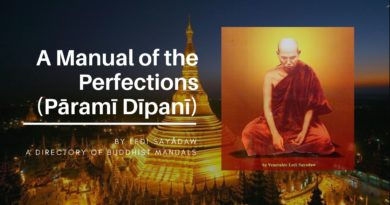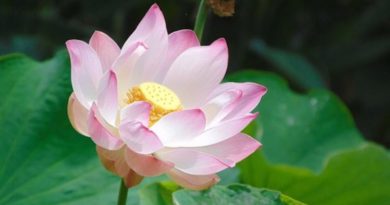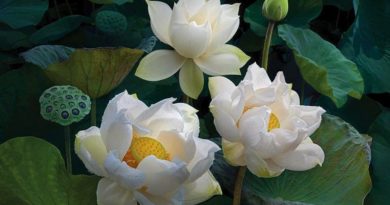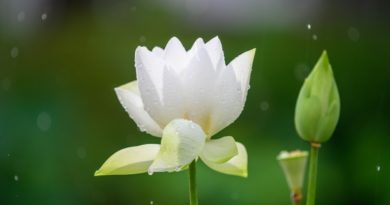ABHIDHAMMA IN DAILY LIFE – CHAPTER 17: DOORS AND PHYSICAL BASES OF CITTA
ABHIDHAMMA IN DAILY LIFE – CHAPTER 17: DOORS AND PHYSICAL BASES OF CITTA
The Buddha pointed out the dangers of being infatuated by the objects we experience through the six doors. He taught people to develop the wisdom which knows the realities experienced through the six doors as nama and rupa, phenomena which are impermanent and not self. What is impermanent is ‘dukkha’, it cannot be happiness. When we come to know things as they are, we will be less infatuated by objects.
We read in the ‘Kindred Sayings’ (IV, Salayatana-vagga, Kindred Sayings on Sense, Second Fifty, Ch. III, par. 81, A brother) about the purpose of the Buddha’s teachings. The text states:
Then a number of monks came to see the Exalted One…. Seated at one side those monks said to the Exalted One:- –
‘Now here, lord, the wandering sectarians thus question us: ‘What is the object, friend, for which the holy life is lived under the rule of Gotama the recluse?’ Thus questioned, lord, ‘we thus make answer to those wandering sectarians : ‘It is for the full knowledge of dukkha that the holy life is lived under the rule of the Exalted One. Pray, lord, when, thus questioned, we so make answer, do we state the views of the Exalted One, without misrepresenting the Exalted One by stating an untruth? Do we answer in accordance with his teaching, so that no one who agrees with his teaching and follows his views could incur reproach?’
‘Truly, monks, when thus questioned, You thus make answer, you do state my views.. in stating that it is for the full knowledge of dukkha that the holy life is lived under my rule.
But if, monks, the wandering sectarians should thus question you : ‘But what, friend, is that dukkha, for the full knowledge of which the holy life is lived under the rule of Gotama the recluse?’- – thus questioned you should answer thus: ‘The eye, friend, is dukkha. For the full knowledge of that the holy life is lived… Objects…that pleasant or unpleasant or indifferent feeling that arises through mind-contact,- – that also is dukkha. Fully to know that, the holy life is lived under the rule of the Exalted One.’ Thus questioned, monks, by those wandering sectarians, thus should You make answer.’
In being aware of nama and rupa which appear, such as seeing, visible object, feeling or thinking, we can prove the truth of the Buddha’s teachings by ourselves ; we can prove that the objects experienced through the six doors are impermanent and not self. The truth will not be known if one follows other people blindly or if one speculates about the truth. We read in the ‘Kindred Sayings’ (IV, Salayatana-vagga, Third Fifty, Ch. V, par. 152, Is there a method?) that the Buddha said:
‘ls there, monks, any method, by following which a monk, apart from belief, apart from inclination, apart from hearsay, apart from argument as to method, apart from reflection on reasons, apart from delight in speculation, could affirm insight thus : ‘Ended is birth, lived is the righteous life, done is the task, for life in these conditions there is no hereafter?’ ‘For us, lord, things have their root in the Exalted One… Well indeed were it if the meaning of this that has been spoken were to manifest itself in the Exalted One. Hearing it from him the monks will remember it.’
‘There is indeed a method, monks, by following which a monk….could affirm insight…And what is that method?
Herein, monks, a monk, seeing an object with the eye, either recognizes within him the existence of lust, malice and ignorance, thus : ‘I have lust, malice and ignorance’, or recognizes the non-existence of these qualities within him, thus: ‘I have not lust, malice and ignorance.’ Now as to that recognition of their existence or non-existence within him, are these conditions, I ask, to be understood by belief, or by inclination, or hearsay, or argument as to method, or reflection on reasons, or delight in speculation?’
‘Surely not, lord.’
‘Are not these states to be understood by seeing them with the eye of wisdom?’
‘Surely, lord.’
‘Then, monks, this is the method by following which, apart from belief… a monk could affirm insight thus: ‘Ended is birth…for life in these conditions there is no hereafter.”
The same is said with regard to the ear-door, the door of the nose, the door of the tongue, the body-door and the mind-door.
When we study the Abhidhamma we should keep in mind the purpose of the Buddha’s teachings : the eradication of defilements through the wisdom which realizes phenomena appearing through the six doors as they are. Through this method there will be an end to the cycle of birth and death. We should remember that the Abhidhamma is not a theoretical textbook but an exposition of realities appearing in daily life. We learn about nama and rupa ; we learn about cittas which each have their own function in the sense-door process and in the mind-door process. There are sense-door processes and mind-door processes time and again, and objects are experienced during these processes of citta. If there is awareness of characteristics of nama and rupa when they appear, the panna is developed which can eradicate defilements. This kind of wisdom is deeper than any kind of theoretical knowledge.
Nama and rupa which arise and fall away are conditioned realities, they arise because of different conditions. Through the study of the Abhidhamma we learn about different conditions for nama and rupa. Each reality which arises is dependent on several conditions. For instance, seeing is vipaka, produced by kamma. Visible object conditions seeing by being its object (arammana). lf there is no visible object there cannot be seeing. Eye-sense, the kind of rupa in the eye (pasada-rupa) which is able to receive visible object, is another condition for seeing.
The rupa which is eye-sense can be the door (in Pali : dvara) for seeing. A door or ‘dvara’ is the means through which citta experiences an object. There is eye-sense arising and falling away all the time; throughout our life it is produced by kamma. However, eye-sense is not a door all the time, because there is not all the time the experience of visible object. Eye-sense is a door only when citta experiences visible object. It is the same with the pasada-rupas which are the other sense-organs. They are doors only when they are the means through which citta experiences an object.
The eye-door is the means through which citta experiences visible object. Not only the cittas which are cakkhu-dvaravajjana-citta (eye-door-adverting-consciousness) and cakkhu-vinnana (seeing-consciousness) experience the object through the eye-door, the other, cittas of that process, which are sampaticchana-citta (receiving-consciousness), santirana-citta (investigating-consciousness), votthapana-citta (determining- consciousness), the javana-cittas and the tadarammana-cittas are also dependent on the same door, in order to experience the object. After the rupa which is experienced by these cittas has fallen away, the object can be experienced through the mind-door (mano-dvara).
Cittas arising in a process which experience an object through one of the six doors are vithi-cittas (vithi means: way, course, process). Vithi-cittas are named after the door through which they experience an object. For example, the cittas which experience an object through the eye-door are called cakkhu-dvara-vithi-cittas (cakkhu-dvara means eye-door) ; the cittas which experience an object through the ear-door ; (sota-dvara) are called sota-dvara-vithi-cittas; the cittas which experience an object through the mind-door (mano-dvara) are called mano-dvara-vithi-cittas.
In between the different processes of citta there have to be bhavanga-cittas (life-continuum). Bhavanga-cittas are not vithi-cittas. They are not part of the process of cittas experiencing objects which time and again throughout our life experiencing on the six doors. They experience an object without being dependent on any doorway. As we have seen (Ch. 15), the patisandhi-citta, the bhavanga-cittas and the cuti-citta of one life experience the same object as the last javana-cittas which arose before the cuti-citta of the previous life. The patisandhi-citta, the bhavanga-citta and the cuti-citta are vithi-vimutti-cittas (vithi-vimutti means: process-freed), thus, they are different from the cittas arising in sense-door processes and mind-door processes.
It is useful to classify citta by way of dvara (doorway). If one only classifies citta by way of function (kicca), but not by dvara, one may not know which citta is referred to. For example, the panca-dvaravajjana-citta (five-sense-door-adverting-consciousness) has the function of avajjana (adverting). If one does not know that this citta performs the function of adverting through the five sense-doors, one may confuse it with the mano-dvaravajjana-citta (mind-door-adverting-consciousness) which also perform the function of avajjana. The mano-dvaravajjana-citta, however, performs the function of avajjana only through the mind-door.
Some cittas perform their function only through one door. For example, the two types of citta which are sota-vinnana (hearing-consciousness, which can be kusala vipaka or akusala vipaka), only perform their functions through one door, the ear-door. Some cittas perform their function through more than one door. Sampaticchana-citta (receiving..consciousness) performs its function through five doors, depending on the doorway which is contacted by the object. Santirana-citta has different functions performed through different doorways ; it also performs functions without being dependent on any doorway and this is the case when it performs the function of patisandhi, bhavanga and cuti.
Citta should also be classified according to feeling. For example, santirana-citta can be accompanied by upekkha (indifferent feeling) and by somanassa (pleasant feeling). Santirana-citta which is accompanied by somanassa can perform the function of santirana (investigating) through five doors and the function of tadarammana (registering, occurring after the javana-cittas) through six doors.
When santirana-citta is accompanied by upekkha (and in that case it can be kusala vipaka or akusala vipaka), it can perform five functions:
- The function of santirana through five doors.
2. The function of tadarammana through six doors.
3. The function of patisandhi, without being dependent on any door.
4. The function of bhavanga, without being dependent on any door.
5. The function of cuti, without being dependent on any door.
In the processes of citta the doorway (dvara) is the means through which citta experiences its object. The physical base (vatthu) is another factor which conditions citta by being its place of origin. In the planes of existence where there are nama and rupa, cittas do not arise independently of the body ; a citta which arises has a rupa as its place of origin. When there is seeing, could seeing arise outside the body? When there is hearing or thinking, could these cittas arise without the body? This would not be possible. Where does seeing arise? It could not arise on our arm or in our ear. It needs the eye as its physical base. The cakkhup- pasada-rupa, the rupa in the eye which can receive visible object, is the physical base for the citta which sees. The physical base or vatthu is not the same as dvara or doorway. Although the cakkhuppasada-rupa is both dvara and vatthu for seeing-consciousness, dvara and vatthu have different functions. The eye-door (cakkhu-dvara) is the means through which cittas of the eye-door process experience an object. The cakkhu-vatthu (eye-base) is the physical base, the place of origin for seeing- consciousness. The cakkhu-vatthu is the base only for seeing-consciousness, not for the other cittas of that process. The other cittas of that process have another vatthu The vatthu for hearing-consciousness is the sotappasada-rupa for smelling-consciousness the ghanappasada-rupa, for tasting- consciousness the jivhappasada-rupa, for body-consciousness the kayappasada-rupa.
There is a sixth vatthu which is not one of the pasada-rupas. This is the hadaya-vatthu or heart-base. The hadaya-vatthu is a kind of rupa which is the place of origin for the cittas which are not among the panca-vinnanas (seeing, hearing, etc.) since these cittas have the pasada-rupa as their place of origin. The hadaya-vatthu is different from the mind-door. The mind-door is a citta, the bhavangupaccheda-citta, which is the last bhavanga-citta arising before the mano- dvaravajjana-citta (mind-door-adverting-consciousness). The hadaya-vatthu is rupa, not nama.
When sound contacts the ear-sense, the panca-dvara-vajjana-citta (five-sense-door adverting- consciousness) which arises, has as its place of origin the hadaya-vatthu, but the hearing-consciousness has the sotappasada-rupa as its vatthu. All succeeding cittas of that process, however, have the hadaya-vatthu as their place of origin. All cittas of the mind-door process too have the hadaya-vatthu as their place of origin.
Vithi-vimutti-cittas which experience an object without dependence on any door, also have a physical place of origin. Although they are not dependent on any doorway, they could not, in the planes where there are both nama and rupa, arise without a vatthu. A new life begins when the patisandhi-citta arises; however, there is not only nama, there has to be rupa as well. The hadaya-vatthu is the rupa which is the vatthu of the patisandhi-citta. All bhavanga-cittas and the cuti-citta have the hadaya-vatthu as their physical base.
The five kinds of pasada-rupa are the vatthus of the panca-vinnanas. As regards the vatthu of the two types of kaya-vinnana (body-consciousness, which can be kusala vipaka or akusala vipaka), this can arise all over the body. Any part of the body which has sensitivity, can be vatthu for the kaya-vinnana.
The vatthu is the place of origin not only of citta, but also of cetasikas arising together with the citta. Thus, except in the planes of existence where there is only nama there has to be rupakkhandha as well when the four namakkhandhas arise.
It is useful to classify citta by way of kicca (function), arammana (object), dvara (doorway), vatthu, and in many other ways. In this way we will have a clearer understanding of citta. We should, however, remember that this kind of understanding is not yet the wisdom which eradicates lobha, dosa and moha. In the ‘Kindred Sayings’ (V, Khnadha-vagga, Kindred Sayings about Radha, Ch.I, par. 4, To be understood) we read:
At Savatthi .
As he thus sat at one side the Exalted One thus addressed the venerable Radha:
— ‘I will show you the things to be understood, and the understanding, and the person who has understood. Do you listen to it.’
The Exalted One thus spoke: ‘And what, Radha, are the things to be understood? Body, Radha, is a thing to be understood: so is feeling, perception, the activities. Consciousness is a thing to be understood. These, Radha, are the things to be understood. And what, Radha, is understanding? The destruction of lust, the destruction of hatred, the destruction of ignorance,–this, Radha, is called ‘understanding’.
And who, Radha, is the person who has understood? ‘Worthy’ should he be called, that venerable one of such and such a name, of such and such a clan – – that, Radha, is the meaning of ‘the person who has understood’.’
Sometimes the Buddha reminded people of the purpose of the teachings in a longer discourse, sometimes in a shorter discourse, but one has to be often reminded of the goal. What is the purpose of understanding, if it does not lead to the eradication of defilements?
-ooOoo-
Questions
- Can citta know arammana without being dependent on any doorway?
2. Through how many doors can citta know arammana?
3. Through how many doors does panca-dvaravajjana-citta
(sense-door-adverting-consciousness) experience an object?
4. Through how many doors does mano-dvaravajjana-citta
(mind-door-adverting-consciousness) experience an object?
5. Through how many doors does sota-vinnana (hearing-consciousness)
experience an object?
6. Through how many doors does santirana-citta perform the function
of santirana (investigating)?
7. Does santirana-citta perform the function of patisandhi independent
on a doorway?
8. Of how many cittas is cakkhu-vatthu (eye-base) the vatthu?
9. Of how many ahetuka cittas is hadaya-vatthu (heart-base) the vatthu?
10. Can the sotappasada-rupa (ear-sense) be dvara (door) or vatthu (base)
or both?
11. What are the respective functions of dvara and vatthu?









